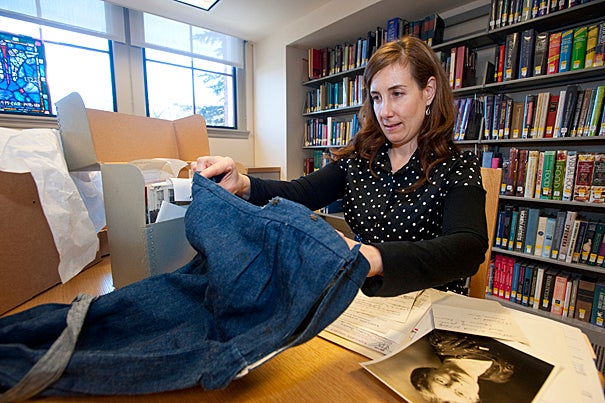
(Cambridge, MA – February 18, 2010) Marilyn Morgan, a Manuscript Cataloger for the Schlesinger Library posses for a portrait with a victorian era bathing suit. Staff Photo Kristyn Ulanday/Harvard University
Kristyn Ulanday/Harvard Staff Photographer
From bodysuits to bikinis
Researcher examines cultural history of women’s bathing suits, and what that reveals about America
Before itsy-bitsy, yellow polka-dotted bikinis detonated on American beaches, women had few options for what they sported in the water. The standard bathing suit for a woman at the turn of the 20th century was around nine yards of wool or flannel that covered everything but her head.
Marilyn Morgan, a manuscript cataloger in the Schlesinger Library at the Radcliffe Institute, is studying the history of bathing suits in America, uncovering lots of secrets — and skin — along the way.
It’s a project that began more than a decade ago when Morgan was a doctoral student in history writing her dissertation. While researching, Morgan was scouring newspapers when she noticed something peculiar: front-page articles devoted to women swimmers.
“This was in the mid-1920s,” she recalled. “So these women swimmers had Babe Ruth to contend against, and the boxer Jack Dempsey, and yet there were more front-page articles on women swimmers than on Babe Ruth.”
Morgan had never heard of these sportswomen, aside from Gertrude Ederle, the first woman to swim the English Channel. “You don’t read about this when you read women’s history,” she said. “It’s just not there.
“And yet swimming was advertised as the sport for women, which I found so interesting. Newspapers said women were just naturally better at it. They thought it was this pure form of activity because women weren’t sweating, they weren’t grunting, and you couldn’t see their bodies in the water.”
Her book in progress, titled “Beauty at the Beach: Marathon Swimmers, the Media, and Gender Roles in American Culture, 1900-1940,” examines not only the evolution of bathing suits but also this pioneering troupe of female long-distance swimmers who became a media sensation at a time when other female athletes “were criticized for being too muscular,” said Morgan.
Women would even compete against men, according to Morgan. “First they covered themselves in seven pounds of lard because the waters were so cold,” she said.
Morgan’s book also will cover topics ranging from the development and marketing of women’s swimwear to the roles that female swimmers played in women’s suffrage. She’s also interested in the emergence of bathing suits in Hollywood and their appearance in the Miss America pageant (which caused it to be “shut down in 1927 for being too risqué,” Morgan noted), and on “Learn to Swim” campaigns, which swept the country promoting swimming as a “desirable activity for women.”
“Even at Radcliffe College,” said Morgan, “every woman had to swim to be able to graduate.”
Last fall, the Harvard University Library (HUL) awarded Morgan a three-month leave through the Extended Professional Development Opportunity Program to work on her independent project. Morgan plans on taking weeks off at a time, traveling to Washington, D.C., and New York City, among other places, to continue her research and to write.
“I am extremely grateful for these wonderful resources that the HUL makes available,” said Morgan, who in 2007 received the Douglas W. Bryant Fellowship, also from the HUL.
Morgan says her everyday job collecting and archiving letters, journals, bills, cards, and other artifacts of women’s history involves “imposing order on chaos.” Perhaps to find balance amid the cartons of donations that arrive at the Schlesinger each day, Morgan volunteered last year to teach free yoga classes to Radcliffe Institute staff and fellows inside the Radcliffe Gymnasium — and she’s in the process of being certified as a yoga instructor.
“I feel really lucky that I get to do what I do for work,” said Morgan. “And I like that I can offer something small back to the Radcliffe Institute community.”




